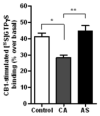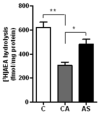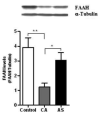Selective alterations of the CB1 receptors and the fatty acid amide hydrolase in the ventral striatum of alcoholics and suicides
- PMID: 20015515
- PMCID: PMC2878847
- DOI: 10.1016/j.jpsychires.2009.11.013
Selective alterations of the CB1 receptors and the fatty acid amide hydrolase in the ventral striatum of alcoholics and suicides
Abstract
Recent studies in rodents have suggested a role for the central endocannabinoid system in the regulation of mood and alcohol related behaviors. Alcohol use disorder is often associated with suicidal behavior. In the present study, we examined whether abnormalities in the endocannabinoid system in the ventral striatum are associated with alcohol dependence and suicide. The levels of CB1 receptors, receptor-mediated G-protein signaling, and activity and level of the fatty acid amide hydrolase (FAAH) were analyzed postmortem in the ventral striatum of alcohol-dependent nonsuicides (CA, n=9), alcohol-dependent suicides (AS, n=9) and nonpsychiatric controls (C, n=9). All subjects underwent a psychological autopsy, and toxicological and neuropathological examinations. The levels of the CB1 receptors and the CB1 receptor-mediated G-protein signaling were significantly lower in the ventral striatum of CA compared to the control group. However, these parameters were elevated in AS when compared to CA group. The activity of FAAH enzyme was lower in CA compared to the control group while it was found to be significantly higher in AS compared with CA group. These findings suggest that alcohol dependence is associated with the downregulation of the CB1 receptors, while suicide is linked to the upregulation of these receptors in the ventral striatum. Alteration in the activity of FAAH enzyme that regulates the anandamide (AEA) content might in turn explain differences in the CB1 receptor function in alcohol dependence and suicide. These findings may have etiological and therapeutic implications for the treatment of alcohol addiction and suicidal behavior.
Copyright 2009 Elsevier Ltd. All rights reserved.
Figures





References
-
- Arango V, Underwood MD, Mann JJ. Serotonin brain circuits involved in major depression and suicide. Progress Brain Research. 2002;136:443–453. - PubMed
-
- Basavarajappa BS, Cooper TB, Hungund BL. Chronic ethanol administration down-regulates cannabinoid receptors in mouse brain synaptic plasma membrane. Brain Research. 1998;79:212–218. - PubMed
-
- Blednov YA, Cravatt BF, Boehm SL, 2nd, Walker D, Harris RA. Role of endocannabinoids in alcohol consumption and intoxication: studies of mice lacking fatty acid amide hydrolase. Neuropsychopharmacology. 2007;32:1570–82. - PubMed
-
- Callado LF, Meana JJ, Grijalba B, Pazos A, Sastre M, Garcia-Sevilla JA. Selective increase of alpha2A-adrenoceptor agonist binding sites in brains of depressed suicide victims. Journal of Neurochemistry. 1998;70:1114–1123. - PubMed
Publication types
MeSH terms
Substances
Grants and funding
LinkOut - more resources
Full Text Sources
Medical
Research Materials

